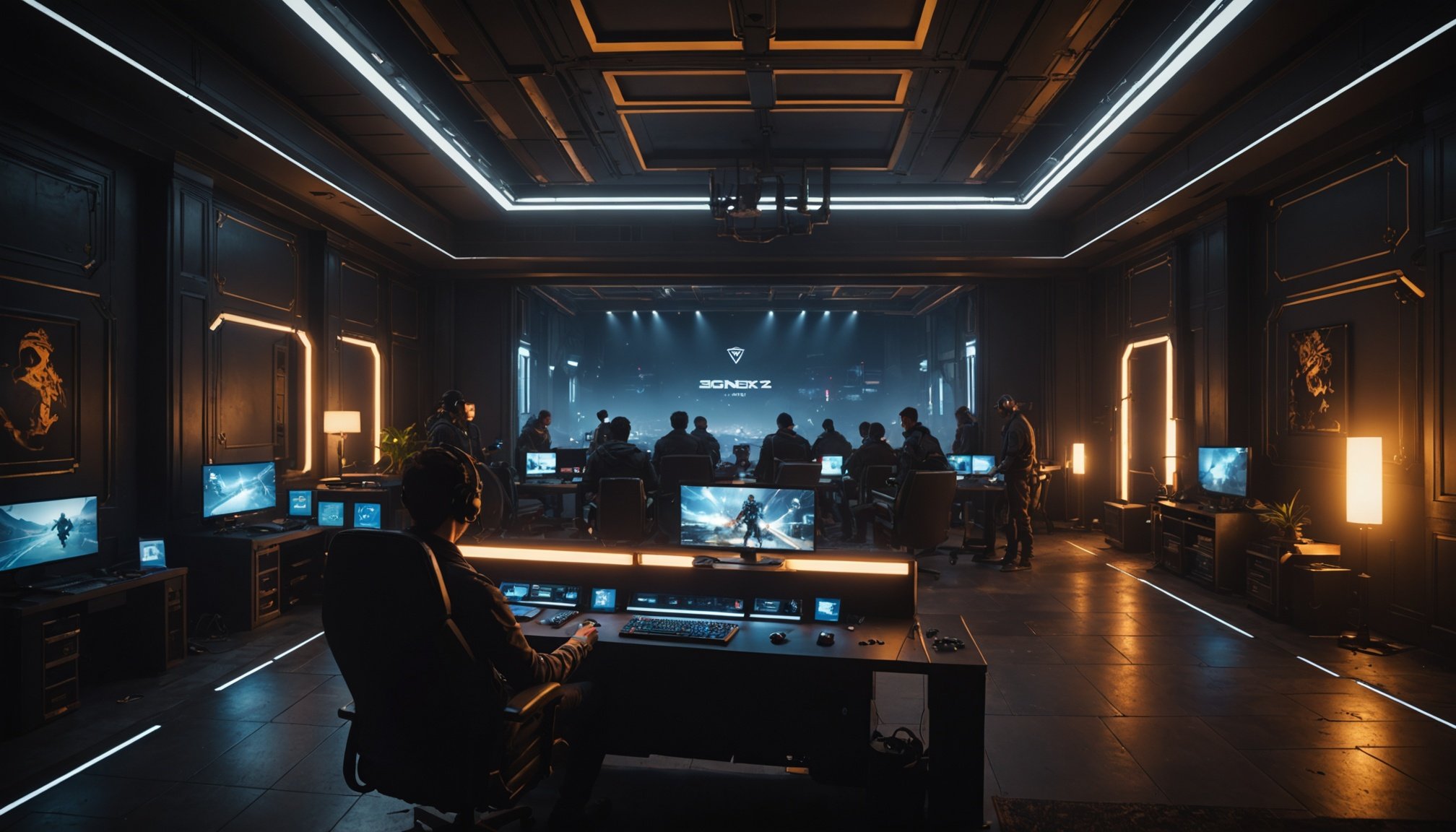Overview of Dynamic Lighting in Gaming
Dynamic lighting in gaming refers to techniques designed to mimic realistic light behavior, enhancing the gaming experience. Unlike static lighting, which remains unchanged, dynamic lighting adjusts to changing environments within the game. This shift enhances visual effects, creating more immersive gameplay.
The evolution of lighting technology in the industry has revolutionised how players perceive in-game worlds. Initially, games used simple, static light sources that failed to adapt to environmental changes. However, modern developments have introduced sophisticated techniques, allowing for realistic rendering of shadows, brightness variances, and light diffusion. These advancements support seamless and interactive environments, significantly boosting immersion.
Also to see : Enhancing RPG Character Diversity: The Power of AI-Driven Voice Synthesis in Creating Unique Character Voices
Impact on player engagement is profound. When dynamic lighting is integrated effectively, it adds depth to virtual worlds, elevating the level of realism and interaction. Players notice and appreciate intricate details like reflections off surfaces and natural shadow progression, which make games more captivating.
Today, many games incorporate dynamic lighting to heighten the player’s sense of presence. By aligning visual effects with game narratives, dynamic lighting contributes not just to aesthetic beauty but also to better gameplay mechanics. Ultimately, these technologies pave the way for future innovations in making gaming even more lifelike and engaging.
Also to see : Revolutionizing Sports Games: Harnessing AI to Craft Authentic Crowd Reactions for an Unforgettable Immersive Experience
Types of Advanced Dynamic Lighting Techniques
Lighting Techniques in video games have significantly evolved, introducing advanced methods powered by Game Engines and Real-Time Rendering. These techniques elevate the realism and visual appeal of virtual worlds, making gaming experiences richer and more immersive.
Ambient Occlusion
Ambient Occlusion is a Lighting Technique used to calculate how exposed each point in a scene is to ambient lighting. By simulating the subtle shading in occluded areas—where light is naturally blocked—it enhances depth perception. This technique contrasts with traditional methods by adding a layer of complexity to shadows and light propagation, enriching the visual narrative of any game environment.
Ray Tracing
Ray Tracing simulates the way light travels, bouncing off surfaces like it does in the real world. Unlike conventional rasterization, it creates high-fidelity reflections and accurate lighting effects, significantly boosting visual effects. This method enhances realism by considering global illumination, refraction, and diffusion more accurately.
Global Illumination
Global Illumination involves comprehensive light simulation that accounts for indirect lighting and light bounces emitted from sources throughout the scene. This approach surpasses traditional techniques by offering a seamless and natural gaming experience, with realistic lighting and shadows dynamically changing in response to in-game actions and environments.
Hardware Solutions for Dynamic Lighting
In the realm of dynamic lighting in gaming, robust hardware solutions are pivotal to enhancing the gaming experience. The integration of suitable gaming hardware such as graphics cards greatly influences the capability to render realistic visual effects. High-performance graphics cards are essential for handling intense lighting calculations without compromising game fluidity. Cards from NVIDIA and AMD are often recommended for their advanced architecture which supports real-time rendering.
Beyond graphics cards, dedicated lighting hardware like LED strips and smart bulbs serve an aesthetic purpose. They synchronize external light sources with in-game actions, adding an immersive element to gameplay environments. This integration can turn a simple gaming setup into an interactive experience that responds dynamically.
Synchronization between hardware and software is critical. This ensures that the lighting effects achieved through game engines sync seamlessly with external lighting setups. Successful synchronization optimizes performance, enhancing both the visual output and the player’s immersive experience.
Investing in lighting accessories elevates game realism. From LED ambient lighting to sophisticated graphics cards, hardware solutions offer diverse avenues for players seeking an enriched gaming adventure. Enhanced performance and aesthetics come together, transforming static surroundings into dynamic play spaces.
Software Tools and Game Integrations
Dynamic lighting has become a staple in game development, largely due to its enhanced visual appeal and immersive potential. Game Development has been revolutionized by the emergence of specialized Lighting Software and Engine Support, making it easier for developers to integrate advanced lighting into games.
Popular Game Engines utilizing dynamic lighting
Engines like Unreal Engine and Unity lead the charge in dynamic lighting integration. They offer native support and advanced capabilities, enabling developers to effortlessly implement lighting techniques. This flexibility enhances a game’s visual effects and gaming experience.
Best lighting plugins and tools for developers
Numerous lighting plugins and tools have been developed to augment game engines. Tools such as “Enlighten” and “TrueSky” facilitate comprehensive lighting management, enabling precise light simulation and offering controls over real-time rendering.
Integration of dynamic lighting in popular titles
Games like “Control” and “Cyberpunk 2077” serve as exemplary cases. These titles leverage dynamic lighting to deliver a rich and realistic gaming experience. The adaptability of software solutions ensures that such experiences are uniform across diverse gaming platforms.
Developers seeking to understand and incorporate advanced lighting techniques can access a multitude of resources and tutorials. This accessibility ensures that even independent developers can create visually compelling games with dynamic lighting features.
Optimizing Lighting for Different Gaming Setups
In the pursuit of creating an exceptional gaming setup, understanding lighting optimization is key to delivering a personalized experience tailored to individual preferences. Both console and PC setups demand different considerations to maximize the immersive power of dynamic lighting.
For console gaming, it’s crucial to ensure that your lighting complements the room environment where most televisions are placed. Dimmers or smart bulbs can be utilized to adjust brightness without causing screen glare. In contrast, PC gamers should focus on how monitor position interacts with ambient light, aiming for a setup that minimizes reflections while enhancing visual clarity. Ergonomic positioning of monitors can further aid in reducing strain during extended gaming sessions.
Moreover, gamers should tailor lighting settings to match specific genres they’re enjoying. Adjusting these settings can elevate the experience by highlighting important game elements and enhancing mood differentiation. For horror games, dim lighting can intensify the atmosphere, while brighter settings can enhance the vividness for vibrant adventure games.
Ultimately, the user’s preferences are paramount. Personalized lighting enables players to adapt their environment according to the game’s demands, thus elevating the overall gaming experience. Through careful adjustment and thoughtful implementation, lighting can transform how games are perceived across different setups.
Case Studies and Examples
By examining Lighting Case Studies, we gain insight into the transformative power of dynamic lighting in enhancing gameplay. Games like “The Last of Us Part II” are prime examples of Successful Implementations, where lighting intricately conveys mood and tension. Its use of natural light to highlight emotional cues heightens the narrative, proving how adept light management enriches storytelling.
Analysis of groundbreaking games with exceptional lighting
Games such as “Cyberpunk 2077” showcase advanced lighting systems, immersing players through neon-infused cityscapes. Meanwhile, titles like “Red Dead Redemption 2” employ dynamic lighting to simulate natural environments, offering a stark contrast to urban settings. These examples emphasize the adaptability of lighting across diverse genres.
Community contributions and modding for enhanced lighting
The gaming community frequently contributes to lighting improvements through modding. Enthusiasts develop mods that adjust ambient light and shading intricacies, further pushing the envelope of player immersion. Such community-driven initiatives are pivotal in exploring new visual paradigms, often leading to unexpected innovations and refinements in games.
Comparing lighting systems across genres
Lighting differences are profound between genres like FPS and RPG. While RPGs leverage detailed Visual Comparisons to craft atmospheric experiences, FPS titles focus on precision and clarity in combat scenarios. Comparing these lighting systems reveals how tailored approaches enhance genre-specific gameplay, enriching the player’s overall experience.











